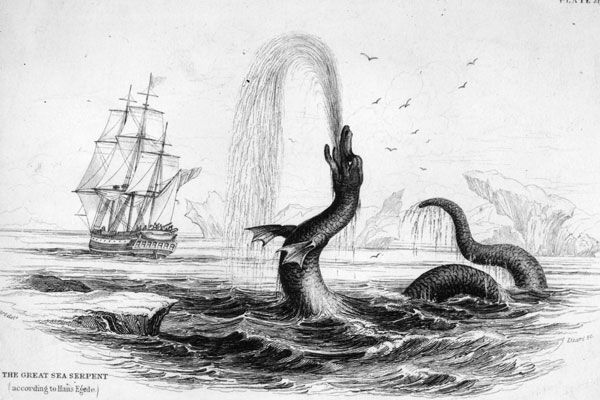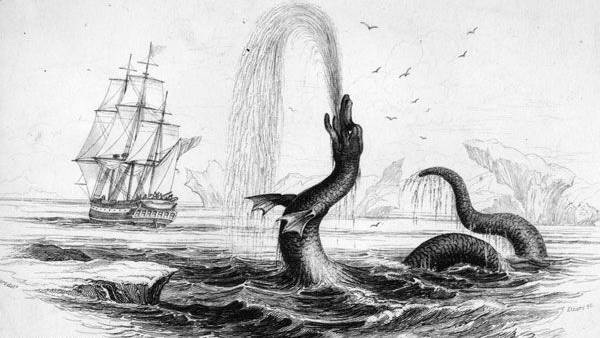Ships’ Logs and Sea Monsters
Source: forteantimes.com
The MoD keeps no secret files, but Admiralty records detail encounters.
The Ministry of Defence does not keep any secret files on sea monsters reported by Royal Navy personnel, but crews of ships and submarines who make unusual sightings can record their experiences in official logbooks that are public records. This emerged as a result of a Freedom of Inform ation request made to the MoD by marine bio logist Sebastian Darby in February. Darby’s request asked the MoD if there were “any abnorm ally large, or dangerous sea monsters hundreds of metres under the sea that haven’t been revealed to the public”. If such creatures did exist, he argued, it would be in the public interest to publish the facts as marine bio logists’ lives could be at risk.
Navy FOI officer Heather Godfrey’s response admitted neither the Navy nor the MoD maintained “any form of central repository of information purely devoted to sea monsters”. Although there was no formal requirement, the Navy did encourage personnel to record sightings of marine mammals “and it’s possible this could include unusual sightings”. All such reports were sent to the UK Hydrographic Office in Somer set, while individual ship’s logs are retained until they are deposited at The National Archives after 30 years. But a search of thousands of ship’s logs for entries on sea monster sightings would exceed the cost limits allowed for a FOI request.
Nautical folklore is replete with such stories and first-hand accounts of sightings have been recorded in Atlantic waters since the Middle Ages. In more recent centuries, one of the most cele brated sea serpent reports was made by the captain and officers of the frigate HMS Daedalus off the Cape of Good Hope in the South Atlantic on 6 August 1848 [...]. On arrival in England, the captain, Peter M’Quhae, sent details to the Admiralty and to The Times. He supervised a detailed drawing of the 60ft-long creature that was visible for 20 minutes. But his story was rejected by palæonto logist Professor Richard Owen, who insisted the crew had seen a giant seal.
A number of other 19th-century accounts have emerged in British Admiralty files deposited at The National Archives in Kew. One contains an account of a sea serpent written by Captain James Stockdale in May 1830. Stockdale and the crew of the barque Rob Roy were near the island of St Helena when they heard a scuffling noise in the water. As they turned to the port bow, they were amazed to see the head of “a great thundering sea snake” whose head rose six feet out of the water “as square with our topsail [and] his tail was square with the foremast”. Stockdale said his ship was 171ft long with the foremast 42ft from the stern, which would make the monster 129ft long. He reported to his masters in London: “If I had not seen it I could not have believed it but there was no mistake or doubt of its length – for the brute was so close I could even smell his nasty fishy smell.”
A Board of Trade file from 1857 contains an account from Comm ander George Henry Harring ton of the 1,063-ton merchant ship Cast ilan, again near the same South Atlantic island. On 13 December of that year, he and two officers saw “a huge marine animal” which suddenly reared out of the water just 20ft from the ship. For a few moments, its long neck and dark head, shaped “like a long buoy” and covered with white spots, were clearly visible “with a kind of scroll or ruff encircling it”. The creature was submerged for a moment and then reappeared, leaving the crew in no doubt they were watching a sea monster “of extraordinary length [which] appeared to be moving slowly towards the land”. The boatswain, who watched it for some time, said that it was more than double the length of the ship, which made it 500ft long.
Both reports appear to have been filed away without comment by the Admiralty, in much the same way that the Air Ministry dealt with reports of flying sauc ers and UFOs from RAF crews during the 20th century. Unless a clear threat was identified, either from sea monsters or aliens, unusual sightings like these were classified as interesting but of “no defence significance”.
[PA] D.Telegraph, 16 May 2010; Rickard & Michell: “The Rough Guide to Unexplained Phenomena”, 2007; National Archives files: BJ 7/49 and MT 9/207.
Article from: ForteanTimes.com






















